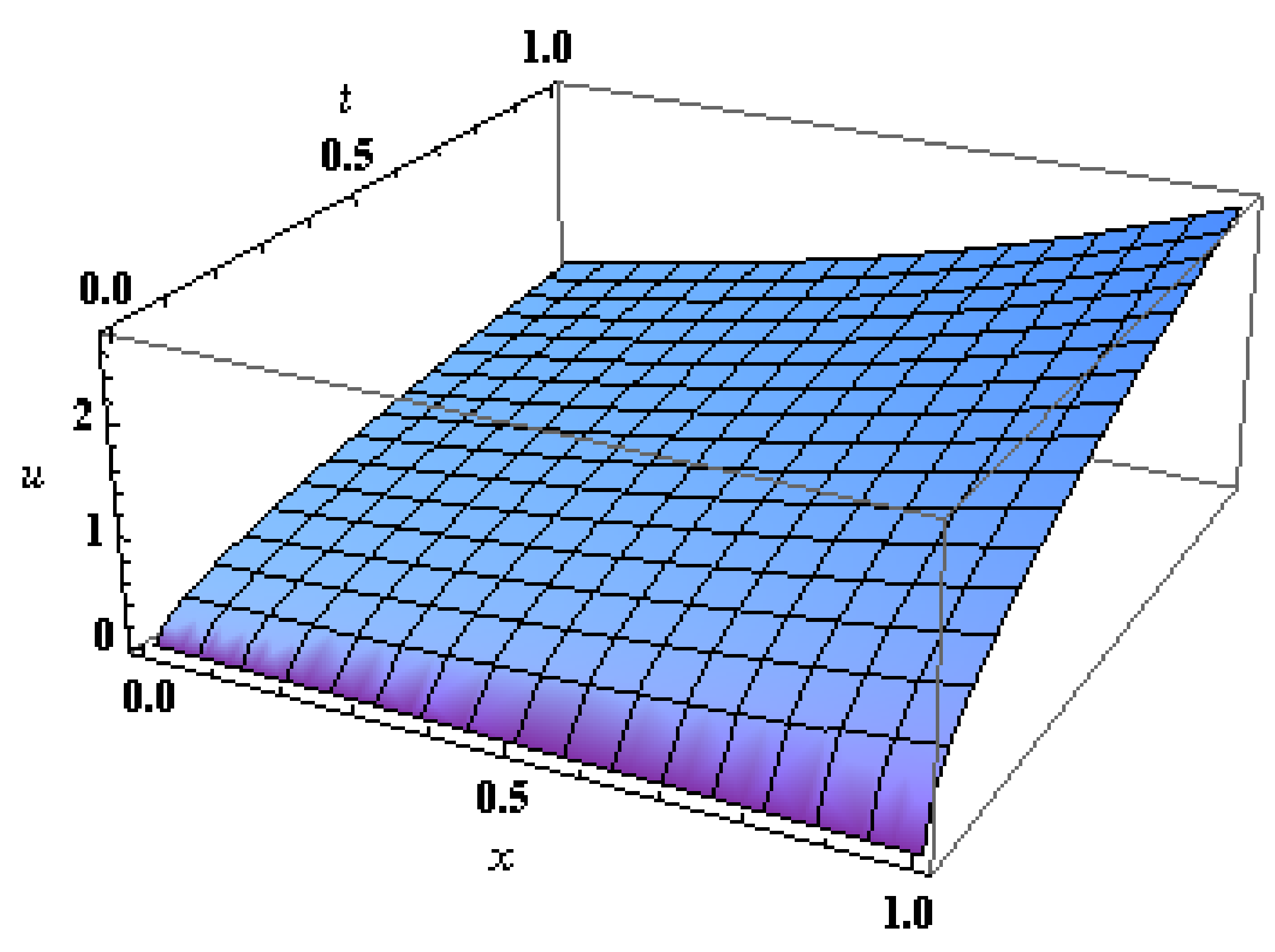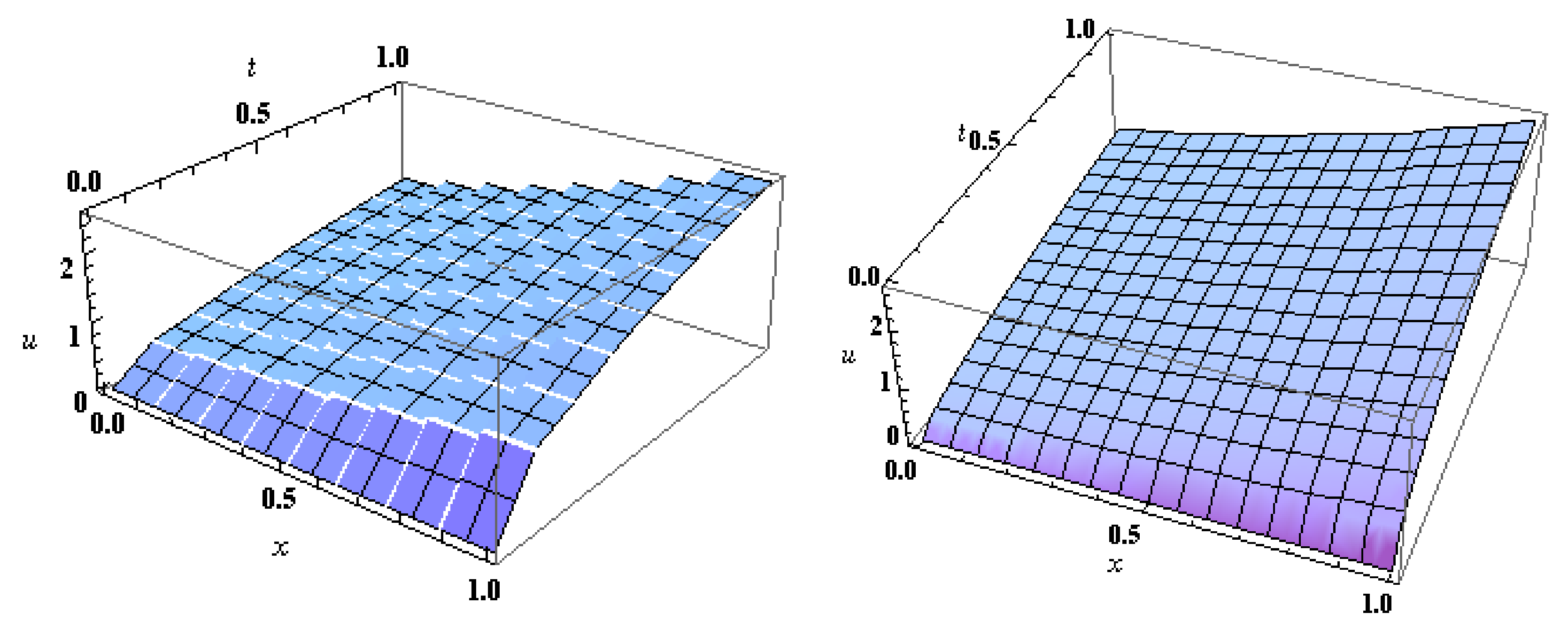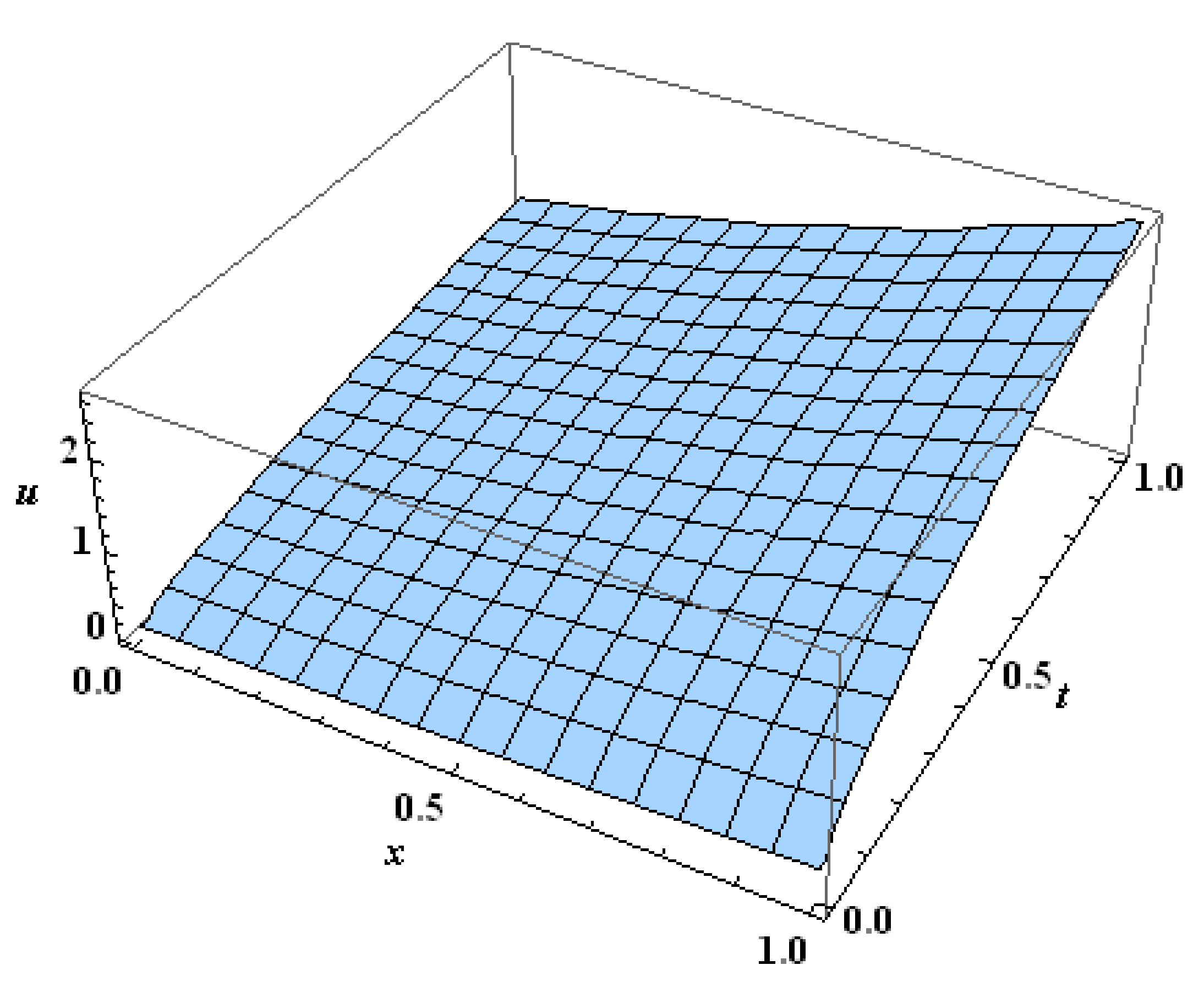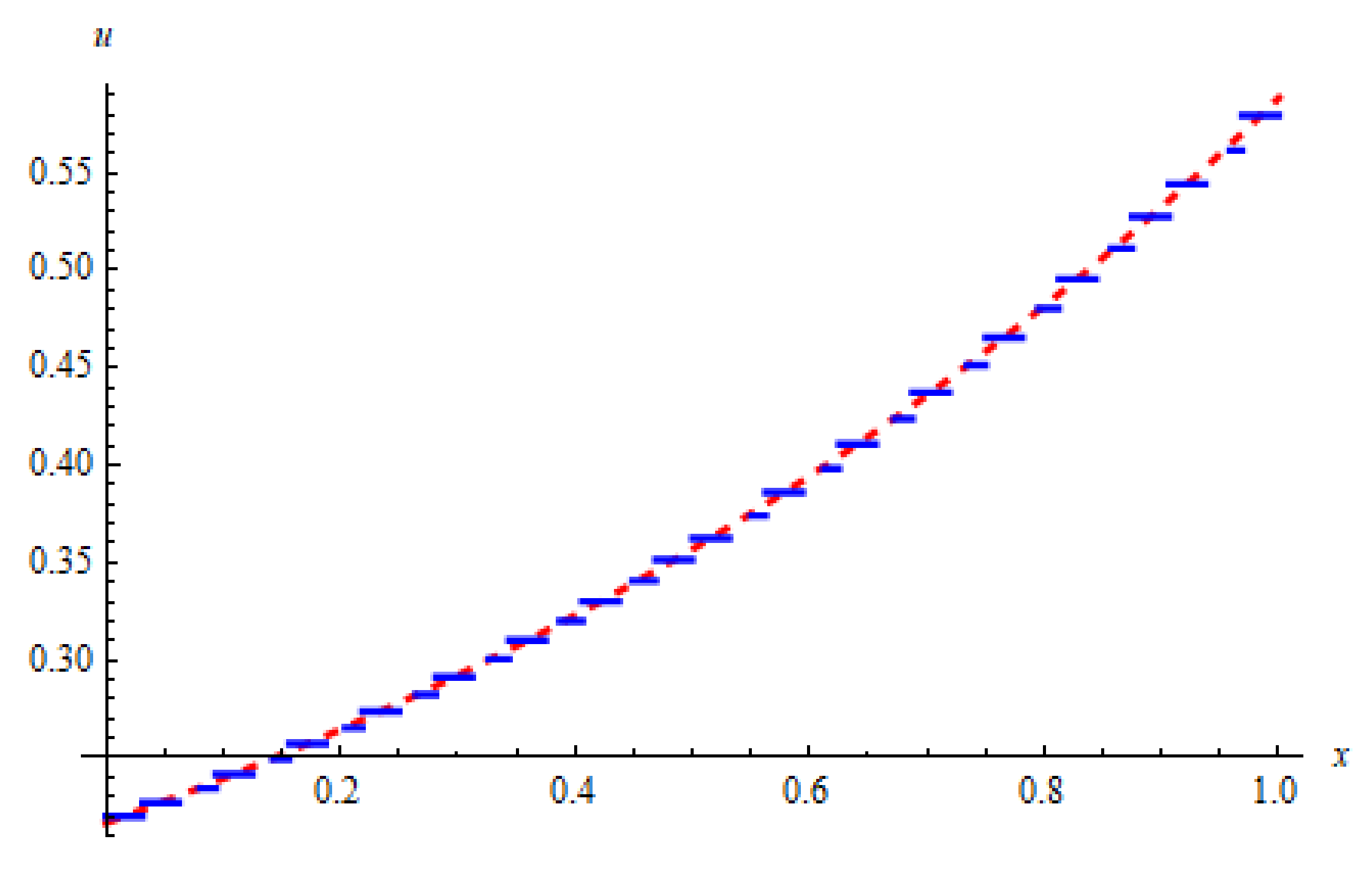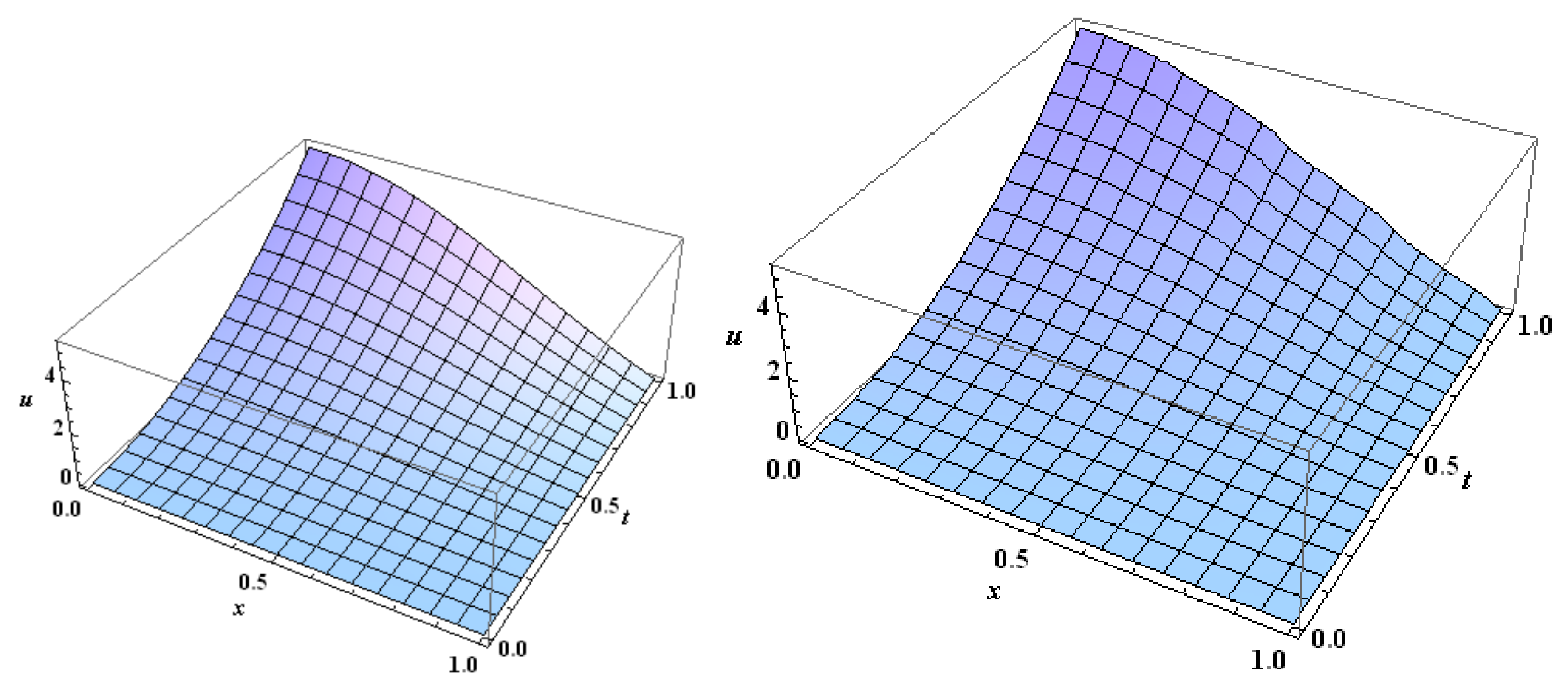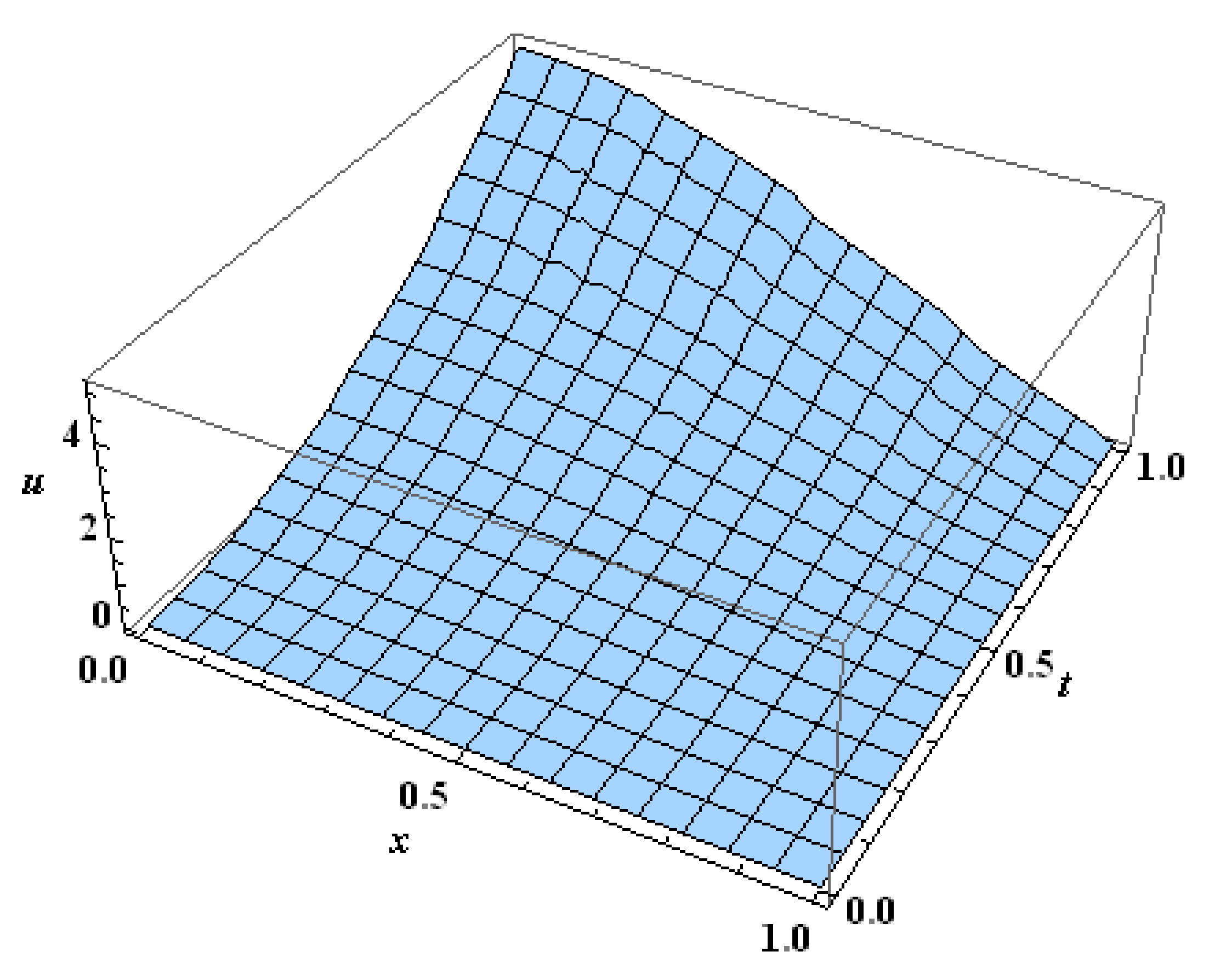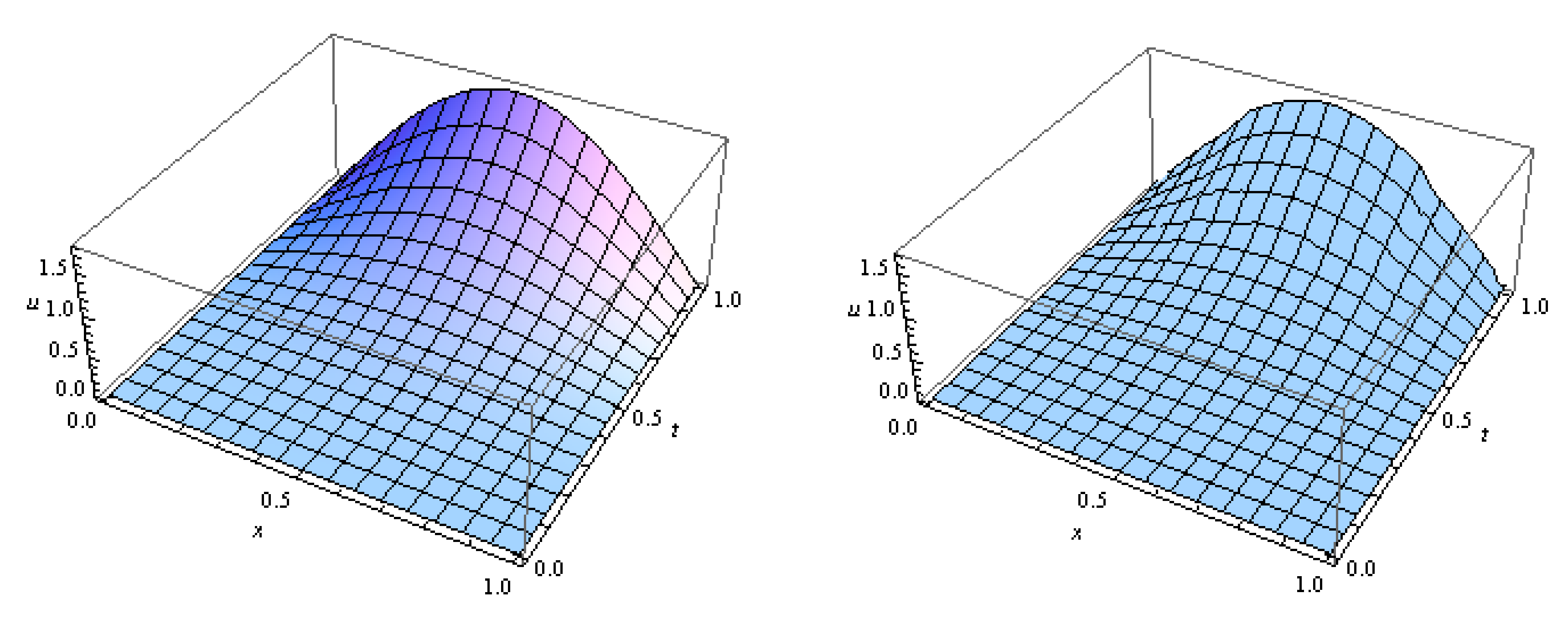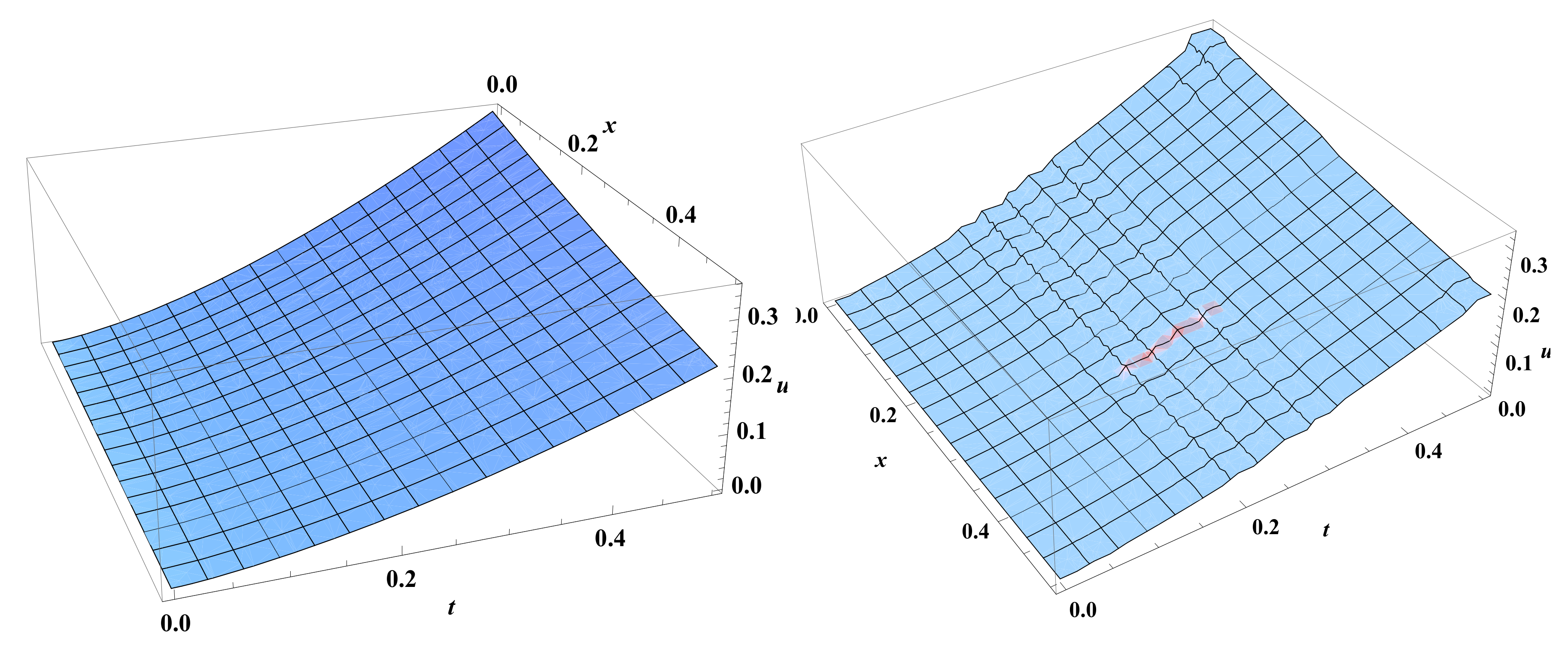Figure 1.
The exact solution for Example 1.
Figure 1.
The exact solution for Example 1.
Figure 2.
The approximate solution for Example 1 at (to the left) and at (to the right) using HWM.
Figure 2.
The approximate solution for Example 1 at (to the left) and at (to the right) using HWM.
Figure 3.
The approximate solution (blue) and the exact solution (red) for Example 1 at , (to the left) and at , (to the right) using HWM.
Figure 3.
The approximate solution (blue) and the exact solution (red) for Example 1 at , (to the left) and at , (to the right) using HWM.
Figure 4.
The approximate solution for Example 1 with level of resolution using LHWM.
Figure 4.
The approximate solution for Example 1 with level of resolution using LHWM.
Figure 5.
The approximate solution (blue) and the exact solution (red) for Example 1 with level of resolution and using LHWM.
Figure 5.
The approximate solution (blue) and the exact solution (red) for Example 1 with level of resolution and using LHWM.
Figure 6.
The exact solution (to the left) and the approximate solution (to the right) at for Example 2.
Figure 6.
The exact solution (to the left) and the approximate solution (to the right) at for Example 2.
Figure 7.
The approximate solution (blue) and the exact solution (red) for Example 2 with level of resolution and using HWM.
Figure 7.
The approximate solution (blue) and the exact solution (red) for Example 2 with level of resolution and using HWM.
Figure 8.
The approximate solution for Example 2 with level of resolution using LHWM.
Figure 8.
The approximate solution for Example 2 with level of resolution using LHWM.
Figure 9.
The approximate solution (blue) and the exact solution (red) for Example 2 with level of resolution and using LHWM.
Figure 9.
The approximate solution (blue) and the exact solution (red) for Example 2 with level of resolution and using LHWM.
Figure 10.
The exact (to the left) and the approximate (to the right) solutions for Example 3 with using LHWM.
Figure 10.
The exact (to the left) and the approximate (to the right) solutions for Example 3 with using LHWM.
Figure 11.
The approximate solution (blue) and the exact solution (red) for Example 3 with level of resolution and using LHWM.
Figure 11.
The approximate solution (blue) and the exact solution (red) for Example 3 with level of resolution and using LHWM.
Figure 12.
The exact (to the left) and the approximate (to the right) solutions for Example 4 with using LHWM.
Figure 12.
The exact (to the left) and the approximate (to the right) solutions for Example 4 with using LHWM.
Figure 13.
The approximate solution (blue) and the exact solution (red) for Example 4 with level of resolution and using LHWM.
Figure 13.
The approximate solution (blue) and the exact solution (red) for Example 4 with level of resolution and using LHWM.
Table 1.
Index computations for Haar basis function at .
Table 1.
Index computations for Haar basis function at .
| j | 0 | 1 | 1 | 2 | 2 | 2 | 2 | 3 | 3 | 3 | 3 | 3 | ... | 3 |
| k | 0 | 0 | 1 | 0 | 1 | 2 | 3 | 0 | 1 | 2 | 3 | 4 | ... | 7 |
| 2 | 3 | 4 | 5 | 6 | 7 | 8 | 9 | 10 | 11 | 12 | 13 | ... | 16 |
Table 2.
Exact, approximate, and absolute error for different values of and in Example 1 with resolution using HWM.
Table 2.
Exact, approximate, and absolute error for different values of and in Example 1 with resolution using HWM.
| | Exact Value | Approximate Value | Absolute Error |
|---|
| 0.015625 | | 0.126968 | 0.0997192 | 2.7249310 |
| 0.109375 | | 0.139448 | 0.10952 | 2.9927310 |
| 0.234375 | 0.015625 | 0.158015 | 0.124103 | 3.3911910 |
| 0.484375 | | 0.202895 | 0.159352 | 4.3543310 |
| 0.734375 | | 0.260522 | 0.202896 | 5.5910210 |
| 0.984375 | | 0.334517 | 0.262728 | 7.1789710 |
| 0.015625 | | 0.335927 | 0.336167 | 2.3968710 |
| 0.109375 | | 0.368944 | 0.369209 | 2.6574410 |
| 0.234375 | 0.109375 | 0.418068 | 0.418372 | 3.0451410 |
| 0.484375 | | 0.53681 | 0.537208 | 3.9822610 |
| 0.734375 | | 0.689277 | 0.689796 | 5.1855410 |
| 0.984375 | | 0.88505 | 0.885723 | 6.7305910 |
| 0.015625 | | 0.491747 | 0.49167 | 7.6837110 |
| 0.109375 | | 0.540078 | 0.540002 | 7.6504310 |
| 0.234375 | 0.234375 | 0.611989 | 0.611913 | 7.6009210 |
| 0.484375 | | 0.785809 | 0.785734 | 7.4812310 |
| 0.734375 | | 1.009 | 1.00893 | 7.3275610 |
| 0.984375 | | 1.29558 | 1.29551 | 7.1302310 |
| 0.015625 | | 0.70693 | 0.706692 | 2.3843510 |
| 0.109375 | | 0.776411 | 0.776173 | 2.3839510 |
| 0.234375 | 0.484375 | 0.879789 | 0.879551 | 2.3833510 |
| 0.484375 | | 1.12967 | 1.12943 | 2.3818910 |
| 0.734375 | | 1.45053 | 1.45029 | 2.3800210 |
| 0.984375 | | 1.86251 | 1.86228 | 2.3776210 |
| 0.015625 | | 1.00778 | 1.00709 | 6.9245310 |
| 0.109375 | | 1.10683 | 1.10614 | 6.9244610 |
| 0.234375 | 0.984375 | 1.2542 | 1.25351 | 6.9243710 |
| 0.484375 | | 1.61043 | 1.60974 | 6.9241510 |
| 0.734375 | | 2.06783 | 2.06714 | 6.9238610 |
| 0.984375 | | 2.65515 | 2.65446 | 6.9234910 |
Table 3.
Exact, approximate, and absolute error for different values of and in Example 1 with resolution using LHWM.
Table 3.
Exact, approximate, and absolute error for different values of and in Example 1 with resolution using LHWM.
| | Exact Value | Approximate Value | Absolute Error |
|---|
| 0.015625 | | 0.126968 | 0.12697 | 1.0431410 |
| 0.109375 | | 0.139448 | 0.139449 | 1.0431410 |
| 0.234375 | 0.015625 | 0.158015 | 0.158016 | 1.0431410 |
| 0.484375 | | 0.202895 | 0.202896 | 1.0431410 |
| 0.734375 | | 0.260522 | 0.260523 | 1.0431410 |
| 0.984375 | | 0.334517 | 0.334518 | 1.0431410 |
| 0.015625 | | 0.335927 | 0.335946 | 1.9319210 |
| 0.109375 | | 0.368944 | 0.368963 | 1.9319210 |
| 0.234375 | 0.109375 | 0.418068 | 0.418087 | 1.9319210 |
| 0.484375 | | 0.53681 | 0.536829 | 1.9319210 |
| 0.734375 | | 0.689277 | 0.689297 | 1.9319210 |
| 0.984375 | | 0.88505 | 0.885069 | 1.9319210 |
| 0.015625 | | 0.491747 | 0.491807 | 6.0600810 |
| 0.109375 | | 0.540078 | 0.540139 | 6.0600810 |
| 0.234375 | 0.234375 | 0.611989 | 0.612049 | 6.0600810 |
| 0.484375 | | 0.785809 | 0.78587 | 6.0600810 |
| 0.734375 | | 1.009 | 1.00906 | 6.0600810 |
| 0.984375 | | 1.29558 | 1.29564 | 6.0600810 |
| 0.015625 | | 0.70693 | 0.707111 | 1.8004610 |
| 0.109375 | | 0.776411 | 0.776591 | 1.8004610 |
| 0.234375 | 0.484375 | 0.879789 | 0.879969 | 1.8004610 |
| 0.484375 | | 1.12967 | 1.12985 | 1.8004610 |
| 0.734375 | | 1.45053 | 1.45071 | 1.8004610 |
| 0.984375 | | 1.86251 | 1.86269 | 1.8004610 |
| 0.015625 | | 1.00778 | 1.0083 | 5.2161810 |
| 0.109375 | | 1.10683 | 1.10735 | 5.2161810 |
| 0.234375 | 0.984375 | 1.2542 | 1.25473 | 5.2161810 |
| 0.484375 | | 1.61043 | 1.61095 | 5.2161810 |
| 0.734375 | | 2.06783 | 2.06835 | 5.2161810 |
| 0.984375 | | 2.65515 | 2.65567 | 5.2161810 |
Table 4.
Exact, approximate, and absolute error for different values of and in Example 2 with resolution using HWM.
Table 4.
Exact, approximate, and absolute error for different values of and in Example 2 with resolution using HWM.
| | Exact Value | Approximate Value | Absolute Error |
|---|
| 0.015625 | | 0.00129766 | 0.00190396 | 6.0629810 |
| 0.109375 | | 0.00127279 | 0.00187079 | 5.9800610 |
| 0.234375 | | 0.00118402 | 0.00175244 | 5.6841710 |
| 0.359375 | 0.015625 | 0.00103945 | 0.00155967 | 5.2022510 |
| 0.484375 | | 0.000852082 | 0.00130985 | 4.5777110 |
| 0.734375 | | 0.000416925 | 0.000729643 | 3.1271810 |
| 0.984375 | | 0.0000205978 | 0.000201207 | 1.8060910 |
| 0.015625 | | 0.0635855 | 0.0631889 | 3.9660710 |
| 0.109375 | | 0.0623666 | 0.0619889 | 3.7777710 |
| 0.234375 | | 0.058017 | 0.0577064 | 3.1057810 |
| 0.359375 | 0.109375 | 0.0509328 | 0.0507317 | 2.0113210 |
| 0.484375 | | 0.041752 | 0.0416927 | 5.9294510 |
| 0.734375 | | 0.0204293 | 0.0206995 | 2.7012710 |
| 0.984375 | | 0.00100929 | 0.00157945 | 5.7015410 |
| 0.015625 | | 0.291974 | 0.291125 | 8.4944410 |
| 0.109375 | | 0.286377 | 0.285561 | 8.1673810 |
| 0.234375 | | 0.266405 | 0.265705 | 7.0002310 |
| 0.359375 | 0.234375 | 0.233875 | 0.233365 | 5.099310 |
| 0.484375 | | 0.191718 | 0.191455 | 2.6357610 |
| 0.734375 | | 0.0938081 | 0.0941167 | 3.0858510 |
| 0.984375 | | 0.00463451 | 0.0054642 | 8.2969210 |
| 0.015625 | | 1.24705 | 1.2456 | 1.4585510 |
| 0.109375 | | 1.22315 | 1.22174 | 1.4069810 |
| 0.234375 | | 1.13784 | 1.13662 | 1.2229510 |
| 0.359375 | 0.484375 | 0.998907 | 0.997984 | 9.2322810 |
| 0.484375 | | 0.81885 | 0.818316 | 5.3479710 |
| 0.734375 | | 0.400665 | 0.401032 | 3.6734210 |
| 0.984375 | | 0.0197945 | 0.0209835 | 1.1889810 |
| 0.015625 | | 5.15042 | 5.14813 | 2.2963910 |
| 0.109375 | | 5.0517 | 5.04948 | 2.2187110 |
| 0.234375 | | 4.69938 | 4.69744 | 1.9415110 |
| 0.359375 | 0.984375 | 4.12556 | 4.12407 | 1.4900510 |
| 0.484375 | | 3.38191 | 3.38101 | 9.0496110 |
| 0.734375 | | 1.65478 | 1.65523 | 4.5391310 |
| 0.984375 | | 0.0817527 | 0.0834443 | 1.6915310 |
Table 5.
Exact, approximate, and absolute error for different values of and in Example 2 with resolution using LHWM.
Table 5.
Exact, approximate, and absolute error for different values of and in Example 2 with resolution using LHWM.
| | Exact Value | Approximate Value | Absolute Error |
|---|
| 0.015625 | | 0.00129766 | 0.00130173 | 4.0672610 |
| 0.109375 | | 0.00127279 | 0.00127686 | 4.0672610 |
| 0.234375 | | 0.00118402 | 0.00118809 | 4.0672610 |
| 0.359375 | 0.015625 | 0.00103945 | 0.00104351 | 4.0672610 |
| 0.484375 | | 0.000852082 | 0.000856149 | 4.0672610 |
| 0.734375 | | 0.000416925 | 0.000420992 | 4.0672610 |
| 0.984375 | | 0.0000205978 | 0.000246651 | 4.0672610 |
| 0.015625 | | 0.0635855 | 0.0635962 | 1.076110 |
| 0.109375 | | 0.0623666 | 0.0623774 | 1.076110 |
| 0.234375 | | 0.058017 | 0.0580278 | 1.076110 |
| 0.359375 | 0.109375 | 0.0509328 | 0.0509436 | 1.076110 |
| 0.484375 | | 0.041752 | 0.0417628 | 1.076110 |
| 0.734375 | | 0.0204293 | 0.0204401 | 1.076110 |
| 0.984375 | | 0.00100929 | 0.00102005 | 1.076110 |
| 0.015625 | | 0.291974 | 0.29199 | 1.5752410 |
| 0.109375 | | 0.286377 | 0.286393 | 1.5752410 |
| 0.234375 | | 0.266405 | 0.26642 | 1.5752410 |
| 0.359375 | 0.234375 | 0.233875 | 0.233891 | 1.5752410 |
| 0.484375 | | 0.191718 | 0.191734 | 1.5752410 |
| 0.734375 | | 0.0938081 | 0.0938239 | 1.5752410 |
| 0.984375 | | 0.00463451 | 0.00465026 | 1.5752410 |
| 0.015625 | | 1.24705 | 1.24708 | 2.2645510 |
| 0.109375 | | 1.22315 | 1.22317 | 2.2645510 |
| 0.234375 | | 1.13784 | 1.13787 | 2.2645510 |
| 0.359375 | 0.484375 | 0.998907 | 0.99893 | 2.2645510 |
| 0.484375 | | 0.81885 | 0.818873 | 2.2645510 |
| 0.734375 | | 0.400665 | 0.400688 | 2.2645510 |
| 0.984375 | | 0.0197945 | 0.0198172 | 2.2645510 |
| 0.015625 | | 5.15042 | 5.15046 | 3.2282910 |
| 0.109375 | | 5.0517 | 5.05173 | 3.2282910 |
| 0.234375 | | 4.69938 | 4.69941 | 3.2282910 |
| 0.359375 | 0.984375 | 4.12556 | 4.12559 | 3.2282910 |
| 0.484375 | | 3.38191 | 3.38194 | 3.2282910 |
| 0.734375 | | 1.65478 | 1.65481 | 3.2282910 |
| 0.984375 | | 0.0817527 | 0.081785 | 3.2282910 |
Table 6.
Exact, approximate, and absolute error for different values of and in Example 3 with resolution using HWM.
Table 6.
Exact, approximate, and absolute error for different values of and in Example 3 with resolution using HWM.
| | Exact Value | Approximate Value | Absolute Error |
|---|
| 0.015625 | | 3.3176510 | 3.0217810 | 2.9586810 |
| 0.046875 | | 9.92110 | 9.6251310 | 2.9586810 |
| 0.109375 | | 2.2778410 | 2.2482510 | 2.9586810 |
| 0.234375 | 0.015625 | 4.5406610 | 4.5110810 | 2.9586810 |
| 0.359375 | | 6.1122110 | 6.0826210 | 2.9586810 |
| 0.484375 | | 6.7532310 | 6.7236410 | 2.9586810 |
| 0.734375 | | 5.0098510 | 4.9802610 | 2.9586810 |
| 0.984375 | | 3.3176510 | 3.0217810 | 2.9586810 |
| 0.015625 | | 0.000113795 | 0.00010996 | 3.8356910 |
| 0.046875 | | 0.00034029 | 0.000336455 | 3.8356910 |
| 0.109375 | | 0.000781299 | 0.000777463 | 3.8356910 |
| 0.234375 | 0.109375 | 0.00155745 | 0.00155361 | 3.8356910 |
| 0.359375 | | 0.00209649 | 0.00209265 | 3.8356910 |
| 0.484375 | | 0.00231636 | 0.00231252 | 3.8356910 |
| 0.734375 | | 0.00171838 | 0.00171454 | 3.8356910 |
| 0.984375 | | 0.000113795 | 0.00010996 | 3.8356910 |
| 0.015625 | | 0.00111971 | 0.00109392 | 2.5782610 |
| 0.046875 | | 0.00334834 | 0.00332255 | 2.5782610 |
| 0.109375 | | 0.00768771 | 0.00766192 | 2.5782610 |
| 0.234375 | 0.234375 | 0.0153247 | 0.015299 | 2.5782610 |
| 0.359375 | | 0.0206287 | 0.0206029 | 2.5782610 |
| 0.484375 | | 0.0227922 | 0.0227664 | 2.5782610 |
| 0.734375 | | 0.0169082 | 0.0168825 | 2.5782610 |
| 0.984375 | | 0.00111971 | 0.00109392 | 2.5782610 |
| 0.015625 | | 0.00988361 | 0.0097253 | 1.5830810 |
| 0.046875 | | 0.0295556 | 0.0293973 | 1.5830810 |
| 0.109375 | | 0.0678591 | 0.0677008 | 1.5830810 |
| 0.234375 | 0.484375 | 0.135271 | 0.135113 | 1.5830810 |
| 0.359375 | | 0.182089 | 0.181931 | 1.5830810 |
| 0.484375 | | 0.201185 | 0.201027 | 1.5830810 |
| 0.734375 | | 0.149248 | 0.14909 | 1.5830810 |
| 0.984375 | | 0.00988361 | 0.0097253 | 1.5830810 |
| 0.015625 | | 0.0829568 | 0.0820248 | 9.3207310 |
| 0.046875 | | 0.248072 | 0.247139 | 9.3207310 |
| 0.109375 | | 0.569567 | 0.568635 | 9.3207310 |
| 0.234375 | 0.984375 | 1.13538 | 1.13445 | 9.3207310 |
| 0.359375 | | 1.52834 | 1.52741 | 9.3207310 |
| 0.484375 | | 1.68863 | 1.68769 | 9.3207310 |
| 0.734375 | | 1.2527 | 1.25177 | 9.3207310 |
| 0.984375 | | 0.0829568 | 0.0820248 | 9.3207310 |
Table 7.
Comparison between HWM and LHWM.
Table 7.
Comparison between HWM and LHWM.
| | Example(1) Using HWM
| Example(1) Using LHWM
| Example(2) Using HWM
| Example(2) Using LHWM
|
|---|
| Computations time using Mathematica 11, at J = 2 | 24 min
| 3 min
| 28 min
| 3.5 min
|
| Computations time using Mathematica 11, at J = 4 | 3 h and 20 min
| 10 min
| 4 h and 35 min
| 12 min
|
| Erorr range at J = 4 | 10–10 | 10–10 | 10–10 | 10–10 |
